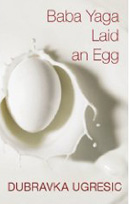
Ugrešić's take on the Slavic Baba Yaga story is part of the Canongate "The Myths" series, for which an outstanding collection of writers have each produced a contemporary retelling of a myth. The prospect of a retelling of Baba Yaga by a writer I admire greatly was too much to resist (particularly after I'd heard Ugrešić read from and talk about this novel at the London Review of Books World Literature Weekend in June). As with others in the Canongate series, no prior knowledge of the myth is necessary to enjoy the novel.
The novel is divided into three distinct sections (so distinct that Ugrešić insisted on having them translated by three different translators), each with a title taken from a Baba Yaga story. Section one is the story of the narrator and her difficult relationship with her capricious elderly mother, for whom she undertakes a strange journey to Bulgaria. Section two, the bulk of the novel, is the story of Pupa, Kukla and Beba, three elderly Croatian ladies who turn up at a Czech spa and pay cash to stay in the best suites. Section three, in a wonderful display of Ugrešić's sense of humour, is a letter from an Eastern European academic, "Aba Bagay", to Ugrešić's editor, in response to a request for help from the latter. We don't see the editor's request, but it clearly runs along the lines of "what on earth does this have to do with Baba Yaga?" - hence Aba Bagay's text, "Baba Yaga for Beginners". It's not as straightforward as it seems, though, for in her enthusiasm Aba Bagay provides far more information than is necessary, so her explanation has everything to do with Baba Yaga, but it is up to the reader to decide how much of it is relevant to the earlier two sections of the novel. (You may not know much about Baba Yaga when you start the novel, but you will by the time you've finished!)
All the main characters are women, and most of them are old ‒ and these old women
are all misfits, odd, eccentric. Here is Pupa in the hotel pool, for example:
"a little old lady on a floating lounger, wearing white socks and a swimming
costume from which the Teletubbies gazed out". Kukla has extraordinarly large
feet and the air around her moves. Any man who gets close to her will come
to a nasty end. Beba has extraordinarly large breasts which she almost has
to carry in front of her. The narrator's mother is fiercely protective of her
dwelling space and is bald under her wig. These quirks and eccentricities are
all part of the Baba Yaga myth, as we learn in part three, and Ugrešić
shares them out among her memorable characters in an examination of women's —
particularly older women's — place in society. It's a serious point, of course,
but playfully made in a tale which joyfully celebrates women and their
relationships with each other, and with the world at large.


Canongate, hardcover, 9781847670663
Canongate (US), paperback, 9780802119278 (February)